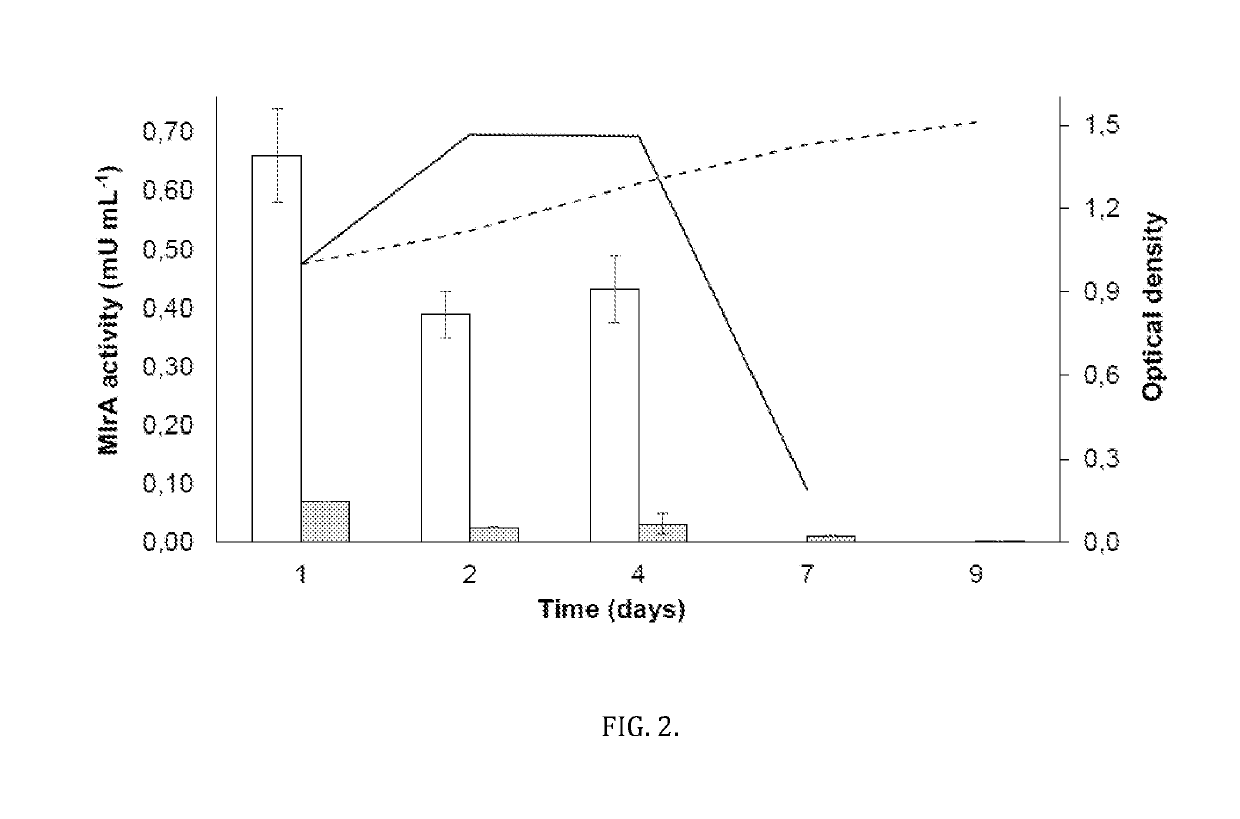Biocatalyst comprising photoautotrophic organisms producing recombinant enzyme for degradation of harmful algal bloom toxins
a photoautotrophic organism and biocatalyst technology, which is applied in the field of biocatalyst comprising photoautotrophic organisms producing recombinant enzymes for degradation of harmful algal bloom toxins, can solve the problems that the current chemical or adsorption-based detoxification process may prove to be more capital intensiv
- Summary
- Abstract
- Description
- Claims
- Application Information
AI Technical Summary
Benefits of technology
Problems solved by technology
Method used
Image
Examples
examples
[0026]Below are presented two examples reduced to practice as noted in the detailed description. Example 1 describes the generation of Synechocystis sp. PCC 6803 strain that is verified to display detoxifying activity towards microcystin-LR (hereafter: 6803mlrAsec+). In addition to displaying genetic stability, this strain shows prolonged activity when cultured in lake water compared to heterotrophic strains modified to express a homologous detoxifying enzymatic pathway. This strain (6803mlrAsec+) was transformed with a genetic cassette (described below) containing Sphingomonas sp. USTB-05 MlrA with a 23 amino acid N-terminal peptide tag consisting of: (from N-terminal) the first 21 amino acids of the Synechocystis sp. PCC 6803 PilA gene (sll1694) followed by a Methionine followed by a Glycine.
[0027]Example 2 describes a second Synechocystis sp. PCC 6803 strain transformed with a genetic cassette (described below) containing Sphingomonas sp. USTB-05 MlrA with no 23 amino acid N-term...
example 1
n and Analysis of 6803mlrAsec+
[0028]Genetic components described below were incorporated into a synthesized expression cassette targeting Sphingopyxis sp. USTB-05 mlrA, codon-optimized for expression in 6803, for double homologous recombination into the Synechocystis sp. PCC 6803 genome. The cassette utilizes the strong cpcB560 promoter to drive mlrA expression, flanking homologous recombination sequence for integration at the slr0271 genomic locus, and incorporation of the native PilA (sll1694) 5′-leader peptide sequence in an attempt to secrete MlrA enzyme into the extracellular space. Other features of the cassette are the aphAI kanamycin resistance gene for selection and the BBa_B0014 BioBrick bi-directional transcriptional terminator downstream of the mlrA gene.
[0029]Additionally, the final base pair of the cpcB560 promoter was changed from A to C to allow for incorporation of an NcoI restriction enzyme site in the expression cassette.
[0030]The above 3749 bp expression cassette...
example 2
n of 6803mlrAsec−
[0046]An attempt was made to express the native MlrA enzyme, with the N-terminus 23 amino acid PilA tag removed from the expression cassette. Generation of this plasmid was performed as follows. Plasmid 6803mlrAsec+ was used as the template to generate plasmid 6803mlrAsec− (p6803mlrAsec-), lacking the N-terminus PilA secretion peptide tag. TAKARA PrimeSTAR HS DNA Polymerase was used according to protocol with 5′ phosphorylated primers 9FW / 10REV to amplify the p6803mlrAsec+ plasmid excluding the PilA secretion peptide (primer 9FW is given as SEQID No: 4, primer 10REV is given as SEQID No: 5).
[0047]Note that primer 10REV 5′ terminus initiates with a thymine (T) base, this was an attempt to reconstitute the original cpcB560 promoter via primer-directed mutation. Recall that the cpcB560 promoter in the p6803mlrAsec+ synthetic construct used as the template has a C substituting the A of the 3′ terminal base, allowing for the incorporation of a NcoI site. Thus, the design...
PUM
| Property | Measurement | Unit |
|---|---|---|
| optical density | aaaaa | aaaaa |
| temperature | aaaaa | aaaaa |
| concentration | aaaaa | aaaaa |
Abstract
Description
Claims
Application Information
 Login to View More
Login to View More - R&D
- Intellectual Property
- Life Sciences
- Materials
- Tech Scout
- Unparalleled Data Quality
- Higher Quality Content
- 60% Fewer Hallucinations
Browse by: Latest US Patents, China's latest patents, Technical Efficacy Thesaurus, Application Domain, Technology Topic, Popular Technical Reports.
© 2025 PatSnap. All rights reserved.Legal|Privacy policy|Modern Slavery Act Transparency Statement|Sitemap|About US| Contact US: help@patsnap.com


